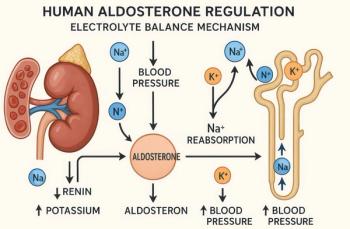
Spigelian Hernia
A 50-year-old man with type 2 diabetes mellitus and hypertension presented to the emergency department with abdominal pain and vomiting of 2 days' duration. He denied fever and urinary symptoms.
A 50-year-old man with type 2 diabetes mellitus and hypertension presented to the emergency department with abdominal pain and vomiting of 2 days' duration. He denied fever and urinary symptoms.
The presumed diagnosis on admission was gastroenteritis. Results of a serum chemistry panel were within normal limits. The patient was treated with intravenous fluids. However, his abdominal pain persisted and bowel sounds were absent. To save time, an emergent CT scan of the abdomen without contrast was obtained. Results showed multiple dilated loops of small bowel from the proximal jejunum in the left upper quadrant and a right anterior abdominal wall defect that contained incarcerated bowel loops (arrow). A right spigelian hernia with a 3-cm wide mouth was the cause of the small-bowel obstruction.
The adhesions were lysed, and the hernia was reduced and repaired. The size of the hernia correlated with the CT finding, and the bowel was viable. The patient's postoperative course was uneventful. He was discharged and scheduled for follow-up.
Spigelian hernia, named after the Flemish anatomist Adrian van der Spieghel, is defined as a protrusion through the spigelian fascia, which is the aponeurotic layer between the rectus abdominas muscle medially and the semilunar line laterally. Spigelian hernias are nearly always found above the level of the inferior epigastric vessels and often occur where the semicircular line-Douglas fold-crosses the linea semilunaris. Affected patients are commonly older than 50 years. The condition affects both sexes equally.
Spigelian hernia is rare and can be difficult to diagnose.1 The presentation varies and depends on the contents of the hernial sac and the degree and type of herniation. The most common symptom is pain, which is nonspecific. A large or palpable orifice or sac can facilitate the diagnosis. Small spigelian hernias are typically hidden by the subcutaneous fat and an intact external aponeurosis. In the absence of obvious clinical signs, persistent point tenderness in the spigelian aponeurosis with a tensed abdominal wall strongly suggests the diagnosis.2
Patients who complain of pain but have no visible or palpable lump present the greatest diagnostic challenge.3 Noninvasive imaging modalities, such as ultrasonography, CT, and MRI, can effectively detect occult abdominal wall hernias.1
Outcome after surgery is excellent, and the risk of recurrence is low.3
References:
REFERENCES:
1.
Sen G, Lochan R, Joypaul BV. Herniography (peritoneography) for diagnosis of Spigelian hernia.
Scott Med J
. 2005;50:124-125.
2.
Spangen L. Spigelian hernia.
World J Surg.
1989;13:573-580.
3.
Kalaba Z. Spigelian hernia. A case of typical Spigelian hernia in an elderly man [in Danish].
Ugeskr Laeger
. 1999;161:2095-2096.
Newsletter
Enhance your clinical practice with the Patient Care newsletter, offering the latest evidence-based guidelines, diagnostic insights, and treatment strategies for primary care physicians.


















































































































































































































































































